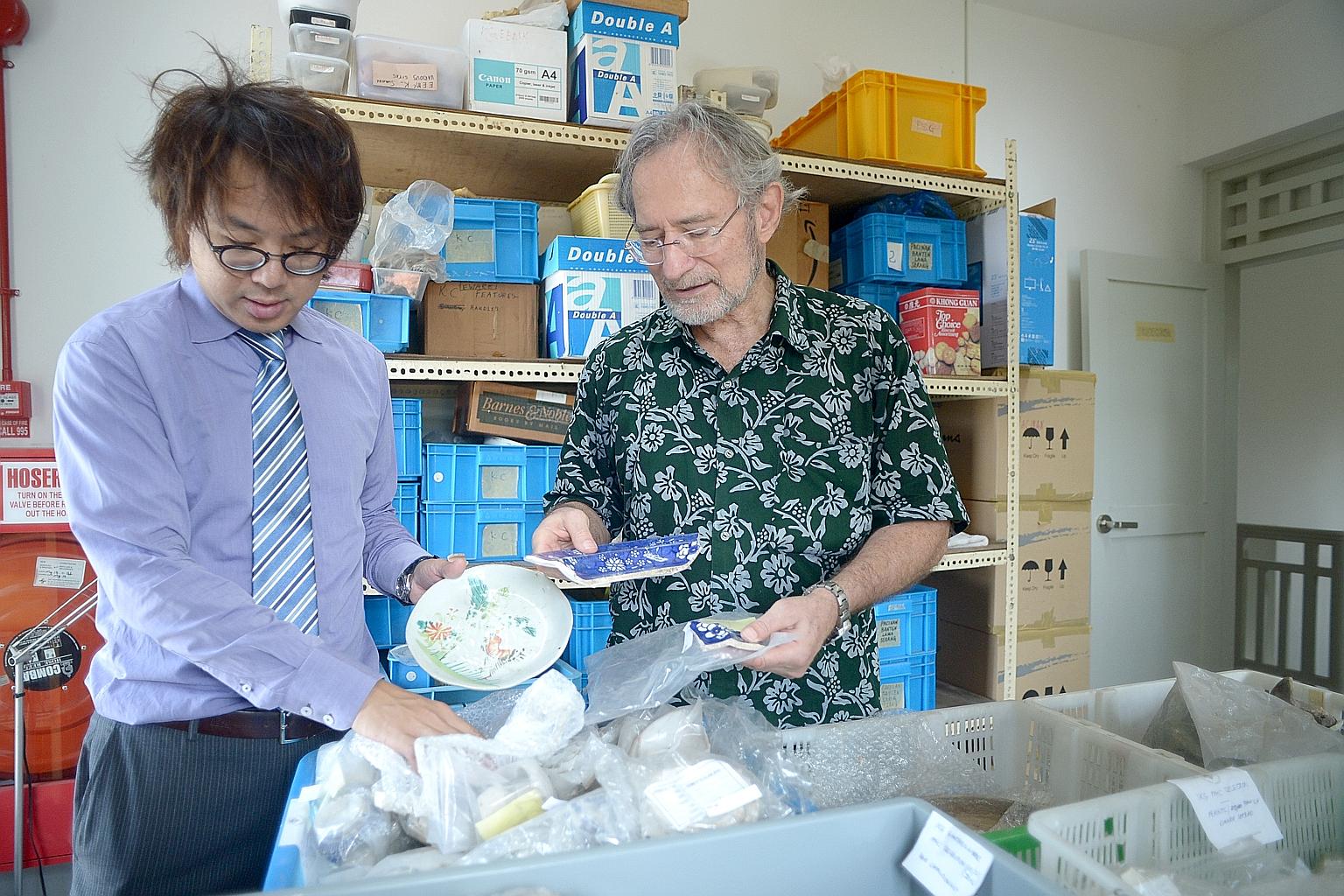Archaeologists in need of funds and resources
A lot of heritage material to be dug up and a big hurry to build up S'porean team: Experts
Sign up now: Get ST's newsletters delivered to your inbox

Mr Lim Chen Sian (left) and Dr John Miksic, both archaeologists, say they need greater resources and manpower to work on the haul of artefacts unearthed so far and to conduct more digs at sites they have identified.
ST PHOTO: JAMIE KOH
Melody Zaccheus
Follow topic:
Singapore's two archaeologists, dogged for years by lack of interest in the field and scant resources, are hoping the Government will pump "several million dollars" into the discipline, to pay for more staff and activities over the next 50 years.
Mr Lim Chen Sian, who led a recent Empress Place dig which yielded artefacts such as centuries-old Chinese imperial grade ceramics, is also creating a registry of archaeological sites so people can be alerted to their historical value before the wrecking balls descend.
The authorities are also keen for archaeology to play a bigger role in piecing together Singapore's past.
Mr Alvin Tan, assistant chief executive of policy and development at the National Heritage Board (NHB), said talks about potential archaeological sites are under way.
"Archaeology matters because it offers insights into our past, allows us to better understand our history and how far we've progressed as a people and a nation," he said.
Mr Lim works for the Nalanda-Sriwijaya Centre at the Institute of Southeast Asian Studies (Iseas).
The other archaeologist here is veteran John Miksic of the National University of Singapore.
Mr Lim's work is supported by research officers Aaron Kao and Michael Ng while Dr Miksic, 69, has the assistance of Dr Geok Yian Goh, an assistant history professor at Nanyang Technological University.
Mr Ng said archaeology is "neglected", adding: "There's a lot of heritage material under us to plug gaps in existing historical sources but we're constantly battling with time to clear backlogs of previous digs. We need more resources."
Many areas with archaeological significance
Areas such as Raffles' Landing Site, Kampong Glam, Pulau Ubin, Pulau Tekong, Sembawang, Bedok and East Coast have been deemed significant by archaeologists.
Portuguese maps show that East Coast, for instance, was an area filled with settlements - such as a village at Sungei Bedok - in the 1600s. So far, excavations in Singapore have recovered artefacts from the Temasek Age, of which almost no written records exist, and have proven that the settlement's history dates as far back as the 14th century.
However, the majority of digs here have been for rescue purposes, with archaeologists scrambling to organise excavations upon hearing of new construction projects.
In the case of Empress Place, for instance, archaeologists rushed to salvage three tonnes of 700-year-old artefacts as the deadline to develop the area into an integrated arts, culture and lifestyle precinct loomed.
The archaeologists discovered that Temasek could have had an established government with a ruler as early as the late 14th century, through the discovery of imperial-grade ceramics bestowed by the Ming Dynasty emperor Hongwu on overseas leaders.
These recovered Empress Place artefacts are in the process of being catalogued.
It will take another three years to analyse them.
Melody Zaccheus
As well as digs and research work, government investment could fund at least five archaeologists and four part-time research assistants, according to 45-year-old Mr Lim.
There is no publicly available data on how much Singapore spends on archaeology but an excavation like the recent 10-week-long dig at Empress Place was budgeted at $70,000 by the NHB.
Last year, Hong Kong, which has about six full-time archaeologists, spent $153,500 on excavations and $26,000 on its Archaeological Society. Malaysia's Centre for Global Archaeological Research got about $3.6 millionin government funding in 2009. Even Brunei, a country with a population of 400,000, has four dedicated archaeologists.
Mr Lim hopes future teams here will have experts in areas such as underwater archaeology, anthropology, and geo-archaeology. "There's a big hurry to build up a strong Singaporean team," he said.
Heritage experts believe the field should come under a government department, which can develop the existing infrastructure, come up with guidelines and police the field.
The authorities have supported archaeological research here since the first dig in 1984 at Fort Canning.
Recent examples supported by the NHB include excavations at Adam Park from 2010 to 2013 and the Victoria Concert Hall in 2011.
Mr Lim said the NHB has been doing more for the scene over the years, such as by setting up an impact assessment and mitigation division in 2013, which works with archeologists at sites of interest before they are developed.
"We've been running on passion and ideology but we need to elevate the level of professionalism. We can't always be digging into our own savings, working 12-hour days and relying on volunteers," he said.
Dr Miksic wants Singapore to be a regional hub for the field.
"We have developed a system of analysis over 30 years. We can work together to build a picture of South-east Asia," he said.

